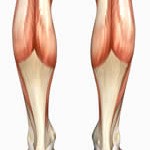Have you ever strained or even torn your calf muscle? And then, just when you thought you were all healed…it happened again? While there are several possible reasons for such a recurrence, one lesser known factor has to do with the anatomy of the calf. 
As you may know, the “calf muscle” is really a collection of several muscles (7 to be exact). But the most prominent one is called the Gastrocnemius, or Gastroc for short. It’s the one that’s easily visible when you walk or do a toe-raise. If you look closely, you’ll notice a vertical indentation dividing the “meaty” portion of the muscle in half. What you’re seeing are the two heads of the muscle, called the medial (inside) and lateral (outside) heads. While they’re still just one muscle, each head can function to varying degrees depending on your body mechanics. If you tend– as many people do– to walk/run with your leg toed-out, you will use your lateral gastroc more than the medial head (and vice-versa). This makes your lateral head the go-to part of the muscle and renders the medial head relatively “out of shape.” As a result, the medial part will be prone to injury, just as any out of shape muscle would be.
Injury of the medial gastroc occurs so frequently in tennis that it has been termed “tennis leg,” though similar injury can result from any activity requiring explosive force and sudden stopping. After being chronically under-used, the medial head is simply ill equipped to handle the high demands it suddenly faces in such situations. As the weak link, it is disproportionately susceptible to strain or tear.
For most people, correcting the imbalance simply requires a conscious effort to exercise both parts of the gastroc. Doing calf raises with your leg/foot pointing straight forward rather than angled out is a good start. If you want to target the medial head more than the lateral head, you can do the exercise with your leg/foot angled slightly inward. The way to monitor yourself is fairly easy: note where you feel the burn. Whatever’s burning is working.
TIP: Try to do exercises that target both heads of the gastroc muscle and try not to walk with your foot angled outward.
